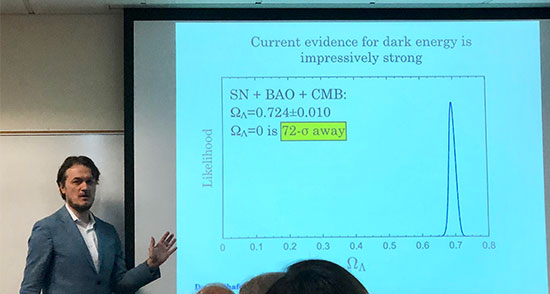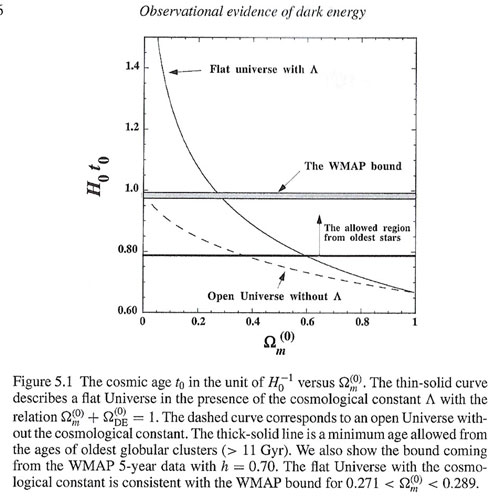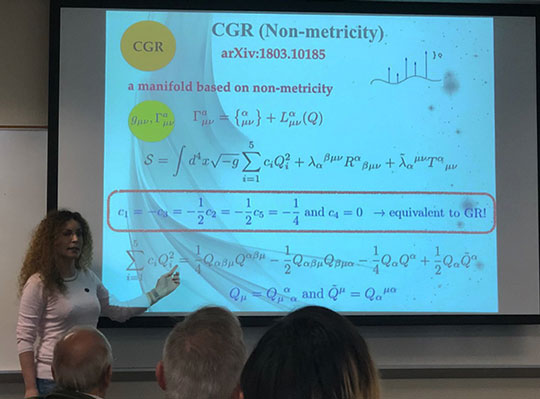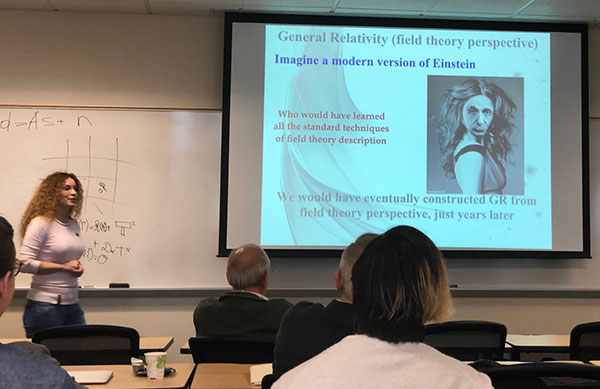Well we are starting to pack our bags for our journey to search for the northern lights in Fairbanks, Alaska, but the weather forecast is looking a bit troublesome. But in the meantime, we can make a documentary movie recommendation and make some comments from our attendance at the Philosophy of Dark Energy Workshop.
So the weather forecast for Fairbanks Alaska shows not a big chance of precipitation, less than 10%, but the cloud forecast runs from partially cloudy to mostly cloudy. Hmm, that is just standard news for astronomers, so we will just hope for the best.
 |
| Cloudy weather forecast might impact our search for northern lights in Fairbanks, Alaska (Source: www.weather.com) |
We can report some good news that we have received from two different sources, both recommending the documentary, Apollo 11, which is just out in the theaters now. Wants to put an Amateur Telescope in Orbit, Randy, alerted us to the just released documentary. He strongly recommended it and another OCA astronomer, Science Nerd and Theatre Impresario, Scott, also gave a big thumbs up on the movie. We are trying to get it on our schedule, but things are really busy right now. Anyway, thanks for that recommendation, Randy and Scott!
Ok, the other news this week comes from our attendance at the Philosophy of Dark Energy Workshop held at UCI, March 8-10. This workshop brought together about 40 professional physicists and professional astronomers, as well as 7 of our local Science Squad, of which I am a member. It was really neat sitting in on the presentations and discussions and I will try to make some brief comments about topics that stood out for me. Good to see so many of our little local group of "physicist wannabe" or as some say, "poseurs", pretending to be part of the professional crowd of real physicists and astronomers. Hmm, nope, we are just having fun and exploring our long lived dream of understanding the physics of the world and cosmos around us! Good to see everyone there!
Jim Peebles, Princeton, offered a "non-empirical assessment" of the Lamda Cold Dark Matter (CDM) model. Jim was instrumental in doing much of the heavy work in cosmology and his 1993 edition of "Principles of Physical Cosmology" is still a classic textbook in the field. He was very active in the workshop and was questioning various points in a very practical and down to earth approach.
Sean Carroll, Caltech, spoke on "Holography, Hilbert Space, and the Cosmological Constant." Sean is a great speaker and I always enjoy hearing him. This time I sort of followed this thought while he was speaking but now that I try to recollect some thoughts it is very hard to do. The one topic that I came away with, deciding that I would have to work out in more detail, was his talk about how the Hilbert space of two black holes changes as the black holes merge. How the dimensionality of the Hilbert space associated with ordinary quantum entanglement as well as in connection with black holes and entropy is a key thing to understand. He also said something to the effect, if I heard it correctly, that gravity could not be explained by an effective field theory. I hope to be able to report more on that and more on the changing dimensions of Hilbert spaces in the future.
 |
| Sean Carroll, Caltech, addresses the UCI Philosophy of Dark Energy Workshop (Source: Palmia Observatory) |
Dragan Huterer, U of Michigan spoke on the two decades of experience of looking for evidence of dark energy. He listed (1) the supernova standard candle identification of universal expansion, (2) the Baryon Acoustic Oscillation measurements, and (3) Cosmic Microwave Background, as the three main lines of evidence. In the slide below, he explains how the evidence for dark energy is very impressive and the three main lines of evidence, when combined, show ridiculously high statistical significant of 72 standard deviations away from being explained by pure chance.
As impressive as the precision in CMB measurements is, he says that future sky surveys of large scale structure (LSS) offer the greatest potential increase in precision and that these measurements will be key in being able to constrain dark energy models and help to isolate and select the most viable models. He said the data is currently much further ahead of the theory!
It turns out that in the March 1 post, Dragan was featured as one of the scientists in a study showing the universe is now measured to be isotropic to within 1%. So it was neat to have read a paper by him and now here he is in person. During the workshop he also commented that some studies have ruled out the objection that we might not be in an expanding universe with dark energy because we jus happen to be located in a part of the universe where there is more void space than in other parts of the universe. Dragan said this has been ruled out and I will try to find that paper and report back on it!
During the coffee break, I mentioned to Dragan how his former professor, Katherine Freeze, had congratulated him on Twitter for the 1% paper. He said he doesn't follow Twitter and did not know of her complement and will have to follow up.
 | |
|
The presentation by Luca Amendola, Institute of Physics, Heidleberg, on "The Ever Changing Dark Energy" dealt with more of the observable effects of dark energy. Of course, we don't measure or observe dark energy, we only measure how its gravitational like effects. His comments during the workshop often went into the nature of observation and modeling of the effects of dark energy and how predictions of its effects are made.
So we don't make measurements of dark energy but instead infer the existence of dark energy because incorporating it in our models of how gravitational theory works and we get a better fit to the observed data. Hopefully, including he idea of dark energy leads us to make other observations which get closer and closer to direct observation, even though it is difficult to get data that is completely independent of some other astrophysical model. Progress is made when observations rule out whole classes of models and we approach the state where fewer and fewer of the alternative theories and models still fit the data. A key point to remember that in philosophy the "problem of eliminating unconceived alternatives" is important here and just because one of the know alternatives is ruled out by observation, it doesn't mean that one of the remaining known available ones is the right one!
 | ||
|
It turned out that I had selected the textbook, Dark Energy: Theory and Observations, as my study guide in order to come up to speed regarding the observations that have been made that convince everyone that some form of dark energy, even though it has not been directly observed, is the largest component of the universe. Rather than present photographs of Luca's slides, I will select some of the figures from his textbook to use instead in commenting about his main lecture points.
 |
| Great textbook, Dark Energy: Theory and Observations, by Luca Amendola & Shinji Tsujikawa |
Strangely, calculations of the age of the universe require some form of dark energy in order to have a model that works correctly. Early researchers were faced with a quandary in that the calculated age of the universe was less than the known age of some stars in the universe. The Friedman Robertson Walker (FRW) metric, which relates general relativistic expansion with the equation of state of material making up the universe, gives the age of the universe too young if only matter and dark matter are included in the calculation. It was only when the estimated amount of dark energy, now something like 70% of the total mass/energy of the universe, was inserted into the models that the age of the universe was at least as old as the oldest stars.
 |
| Observational evidence for Dark Energy (Source: "Dark Energy". Amendola and Tsujikawa) |
Probably the most well known observation that requires dark energy is the supernova data that identified that the expanding universe is not slowing down, as some models had predicted, but is indeed accelerating and expanding. The following chart shows how the predicted value of Hubble constant and luminosity distance depend on the amount of the dark energy terms in the FRW equation. Then the 1998 supernova data identifies the curve using dark energy equal to 70% of the total energy in the universe is the best fit to the observations.
 | |
|
Another line of evidence comes from the measurements of the cosmic microwave background (CMB) by WMAP and Planck satellites, as well as many ground based observations. The following chart shows the famous "peak" in the power spectrum which is used to identify the amount of dark energy to match the observations.
 | |
|
The third line of evidence comes from observations of the large scale structure of the universe. The following chart shows how the amount of dark energy in the models shifts the curve to the left. The key thing to keep in mind is that this shift is exactly what is required to match the observed data. Look for more news from large scale structure surveys in he future.
 | |
|
Take a look at the large scale structure data plotted in the following chart. It lines up pretty well with the curve shown in the previous chart, which includes the dark energy component. So we see that some strange unknown stuff, having the characteristics of dark energy in the FRW equation, is the best fit to the data. But what is this strange dark energy?
 | |
|
So, when all of these lines of evidence are considered together we see how they all converge on a value of about 70% for the dark energy component. Now as the increased precision comes from future sky surveys, the error bars and ovals will become smaller and smaller and many alternative theories of dark energy will be ruled out.
 | |
|
Finally, in a presentation by Lavinia Heisenberg, from ETH Zurich, after she joked about her name and that her family relationship to one of the key pioneers of quantum mechanics, Werner Heisenberg, was "uncertain", she described "The landscape of effective field theories and their consistency tests."
 |
| Lavinia Heisenberg, ETH Zurich, addresses the Philosophy of Dark Energy Workshop (Source: Palmia Observatory) |
One way of explaining what dark energy is starts with modifications to Einstein's General Relativity equations. Maybe some other change or addition to those equations, but still keeping the well established validity of those equations over all known domains of study, can be used to explain how dark energy term is responsible for the observed data, but that there need not be any real component called dark energy. Hmm, we will see.
The recent observation of gravitational waves from merging neutron stars, with the resultant observation of nearly the simultaneous time arrival of gravitational waves and optical waves, has pretty much ruled out theories that had postulated that gravity was mediated by heavy gravitons. So as we go forward, many theories are ruled out and new theories are developed.
In this next slide, one of many showing how changes could be made to Einstein General Relativity equations, while at the same time still agreeing with all known confirmations of GR dynamics calculations, could also exhibit effects associated with dark energy. Here we see how some additional terms that create a non-metricity condition, while still consistent with known measurements by adjusting the "c" constants as shown, might yield some dark energy effects. Without additional observational data, it is hard to know if this "philosophical" addition to the equations might be an explanation for dark energy. It sure would be neat if some scientist were to actually find dark energy without relying on all of these underlying models.
 |
| Lavinia Heisenberg, ETH Zurich, addresses the Philosophy of Dark Energy Workshop (Source: Palmia Observatory) |
Finally, Lavinia asked to consider an "updated", more modern version of Einstein, as shown in the following slide, as the answer to what dark matter is. In the previous slide, she just introduced the idea of non-metricity, but in other slides she introduced other notions of new scalar field additions, or vector field additions, or cross symmetry terms. All of these terms are conveniently left out of the equations when we students study general relativity, but hey, now, maybe to explain dark energy it will be beneficial to include some of them. Hmm, we will have to wait and see! It reminds me of the ongoing debate about what dark matter is. Might it also just be some other component in a modified general relativity equation or might it turn out to be a real particle after all? My guess and bet, I suppose, is that it is still some kind of particle beyond the standard model, but still created in the big bang.
 |
| Lavinia Heisenberg, ETH Zurich, addresses the Philosophy of Dark Energy Workshop (Source: Palmia Observatory) |
One of the more interesting alternative theories that came up for discussion at the workshop was the ideal of Chameleon particles and other ways of generating fifth forces as a way of explaining dark energy. As you know, the current understanding is that there are only four known forces in the universe, but the observation of dark energy effects has caused speculation that perhaps another force, the fifth force, is responsible for these effects. This fifth force has not be observed up to now, because it somehow hides or is screened from observation when measured around the Earth or in other areas where large masses are found, but when the conditions are right, such as being in a large void out in the cosmos somewhere, then the chameleon force can exert its effects and can begin to affect the surrounding environment.
The technical answer of how the screening occurs is currently based on three possible approaches: (1) Chameleon Mechanism, (2) Vainshtein Mechanism, and (3) or the Symmetron Mechanism. I am not able to say anymore about any of these mechanisms other than the general approach by which the screening of the 5th force occurs. When you try to measure it in the Earthbound laboratory, the mass of the Earth affects some of the coupling coefficients in the Hamiltonian and makes the force small by shielding it. We did hear of several new laboratory studies based on Atomic Molecular and Optical (AMO) setups using super cold atoms to measure the mostly shielded small residual of the 5th force. It is neat laboratory work and we will have to wait and see what is found. Any screened fifth force, powerful enough to fill the role of dark energy, must have just enough leakage near the Earth, to be detected in the laboratory. I've read somewhere that the laboratory experiment sensitivity has to be increased by about a factor of 2 in order to rule in or out these screened forces and actually see them in the laboratory!
On hearing about the possibility of Chameleon particles and fifth forces it reminds me of the old philosophical question about how many angels could be on the head of a pin. Well, if we turn to Chameleon particles instead, it seems that if the pin is being considered near the Earth or other large mass, such as the solar system where general relativity has been successfully verified, then no force (or angels) will be found, but move the pin into one of the galactic voids, and then, they start to be counted and affect the motions of nearby galaxies. Pretty convenient! But, the real work in Chameleon theory demonstrates this real connection between philosophy and physics and who is to say that this line of thinking won't at the end of the day be the accepted theory of dark energy!
Ok, that is my summary so far. This has been one of the most difficult workshops to summarize because it has not been just about data and observations, but what is the nature of those observations and how do we tell which of the available interpretive theories is the best one, or do we nave to wait for a more innovative and up to date theory, to explain what dark matter is and why we think it has to be there! But my current thinking is preoccupied with whether to take a meteorology book to Alaska or an astronomy book and see which the weather will support?
Until next time,
Resident Astronomer George
If you are interested in things astronomical or in astrophysics and cosmology
Check out other postings on this blog at www.palmiaobservatory.com

No comments:
Post a Comment